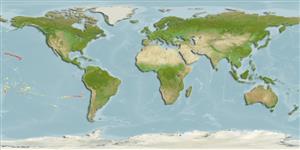Classification / Names
Common names | Synonyms | Catalog of Fishes (gen., sp.) | ITIS | CoL | WoRMS | Cloffa
Actinopterygii (ray-finned fishes) >
Gadiformes (Cods) >
Macrouridae (Grenadiers or rattails) > Macrourinae
Etymology: Hymenocephalus: Named for its transparent membrane-like head covering (‘‘hymen head’’) and fragile nature of head bones (Ref. 100825). More on author: Gilbert.
Environment / Climate / Range
Ecology
Marine; benthopelagic; depth range 101 - 800 m (Ref. 58302). Deep-water, preferred ?
Eastern Central Pacific: known only from the Hawaiian Islands and Sala y Gomez Ridge.
Size / Weight / Age
Maturity: Lm ? range ? - ? cm
Max length : 18.0 cm TL male/unsexed; (Ref. 9949)
Short description
Morphology | Morphometrics
This species is distinguished by the following characters: pelvic fin rays 14-15; pectoral fin rays 15-18; projecting snout, 20-25% HL; rudimentary or very short barbel, 0-3% HL, does not reach vertical through anterior margin of orbit; moderate orbit diameter, 32-39% HL (usually 33-38%HL); infraorbital width 10-12% HL; moderately long preopercular supporter, with obtuse angle at rear margin, 3-4% HL; 25-29 gill rakers; ventral striae reaching to ½ from pelvic fin bases to periproct; otolith has moderately high predorsal lobe, with colliculi separated, closely placed across collum, terminating far from anterior and posterior rims of otolith; otolith length to height (OL:OH), 0.9-1.0; total colliculum length to pseudocolliculum length (TCL:PCL), 1.7-2.0 (Ref. 98298).
Benthopelagic (Ref. 58302). Feeds mainly on pelagic organisms, copepods (Pleuromamma sp., Oncaea conifera, Xanthocalanus sp., Aetideidae spp.); also on small fish, chaetognaths, gammarids (Lysianassidae), shrimp (Bentheogennema pasithea), and mysids (Paralophogaster glaber); benthic polychaetes, including family Polinoidae (Ref. 9949).
Life cycle and mating behavior
Maturity | Reproduction | Spawning | Eggs | Fecundity | Larvae
Sazonov, Y.I. and T. Iwamoto, 1992. Grenadiers (Pisces, Gadiformes) of the Nazca and Sala y Gomez ridges, southeastern Pacific. Proc. Calif. Acad. Sci. 48(2):27-95. (Ref. 9949)
IUCN Red List Status (Ref. 115185)
CITES (Ref. 94142)
Not Evaluated
Threat to humans
Harmless
Human uses
More information
Common namesSynonymsMetabolismPredatorsEcotoxicologyReproductionMaturitySpawningFecundityEggsEgg development
Age/SizeGrowthLength-weightLength-lengthLength-frequenciesMorphometricsMorphologyLarvaeLarval dynamicsRecruitmentAbundance
ReferencesAquacultureAquaculture profileStrainsGeneticsAllele frequenciesHeritabilityDiseasesProcessingMass conversion
Tools
Special reports
Download XML
Internet sources
